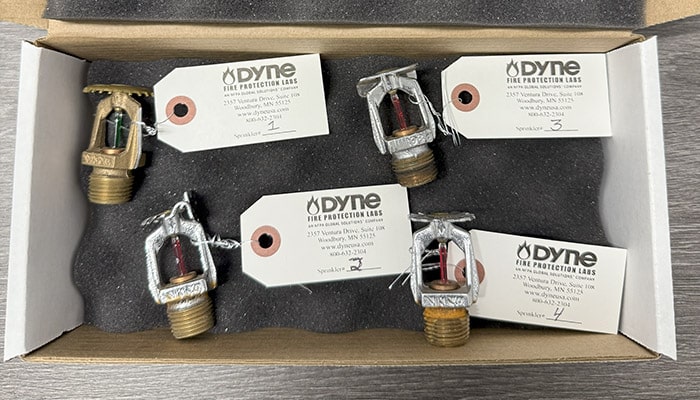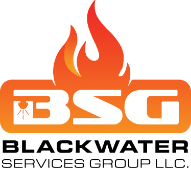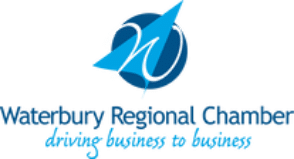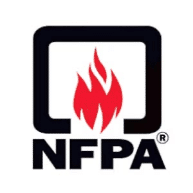
Ensure Your Sprinkler System Is Ready To Go Anytime
Fire sprinkler systems are one of the most effective ways to control or extinguish fires in commercial, industrial, and residential buildings. But like any mechanical system, sprinklers must be properly maintained and tested to ensure they function when needed most. One essential yet often overlooked part of fire protection maintenance is sprinkler head testing.
The photo above shows a real-world example of what sprinkler heads look like once they've been pulled from service and packaged for shipment to a certified lab, such as DYNE Fire Protection Labs. This is a standard step in the inspection and testing process, guided by the National Fire Protection Association (NFPA) standards, specifically NFPA 25 – Standard for the Inspection, Testing, and Maintenance of Water-Based Fire Protection Systems.
If it's been some time since your sprinkler heads were tested, don't wait any longer and leave your property at risk. Message us online or call 475-269-3473
today!
Why Sprinkler Head Testing Matters
Sprinkler heads are installed in ceilings or high areas and exposed to years of environmental factors — dust, corrosion, mechanical damage, temperature fluctuations, and more. Over time, these factors can compromise their functionality. If a sprinkler head fails to activate during a fire emergency, the consequences can be catastrophic.
Here’s why periodic testing is crucial:
1. Code Compliance (NFPA 25 Requirements)
According to NFPA 25, sprinkler heads must be tested at specific intervals depending on the type of head:
-
Standard spray heads: 50 years after installation, then every 10 years.
-
Quick-response heads: Every 20 years after installation, then every 10 years.
-
Dry pendent heads: Every 10 years.
-
Heads exposed to harsh environments may require more frequent testing.
Failing to comply with these intervals can result in code violations, insurance issues, or worse — malfunction in a fire emergency.
2. Verification Of Reliability
Lab testing helps determine if the heads are still operational. The heads are subjected to heat and activation testing to ensure the thermal element (typically a glass bulb or fusible link) will respond correctly under fire conditions.
3. Corrosion & Contaminant Detection
During testing, labs will also examine the heads for internal or external corrosion, contamination, or obstruction that may prevent proper water discharge.
4. Cleaning Guidelines - What NOT To Do
One often-overlooked issue is the cleaning of sprinkler heads. NFPA 25 specifies that sprinkler heads should only be cleaned using compressed air or a vacuum. The use of any other cleaning methods, such as brushes, chemical cleaners, or abrasives, is strictly prohibited. These methods can damage the delicate components of the sprinkler, including the thermal element that activates the sprinkler in case of fire. If the head’s heat-sensing element is compromised, the system may fail to activate when needed most.
It’s crucial to adhere to these cleaning guidelines to avoid voiding warranties or causing failure in an emergency situation. If sprinkler heads have become excessively dirty, a professional should be contacted for proper cleaning or replacement.
5. Peace Of Mind
Sending heads to a certified lab for testing gives building owners, managers, and safety personnel confidence that their systems are ready to respond in a crisis. It’s a small investment for a potentially life-saving payoff.
How Does Sprinkler Head Testing Work?
Once removed, each head is tagged and logged, as shown in the image. They're then packaged with protective foam to prevent damage during transit. At the lab, each head undergoes a series of tests to evaluate functionality, response time, and structural integrity.
If any head fails testing, it signals that other similar heads in the building may also be at risk — which could trigger a broader replacement or more in-depth system evaluation.
Don't Cut Corners With Your Fire Protection
Periodic sprinkler head testing isn’t just a box to check — it’s a vital component of responsible fire protection system maintenance. Partnering with a certified lab and following NFPA 25 ensures your system stays compliant and, more importantly, ready to protect lives and property.
It’s also important to follow the cleaning guidelines outlined by NFPA 25 to ensure the longevity and reliability of your sprinkler heads. Avoid using brushes or harsh chemicals to clean them, and stick to the approved methods of compressed air or a vacuum.
If you’re due for sprinkler head testing or aren’t sure when your last test was, contact us online or call 475-269-3473
today. We can help you stay safe, compliant, and prepared.







